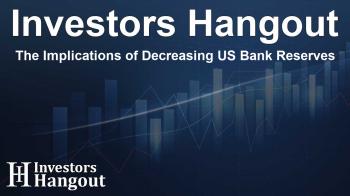The Implications of Decreasing US Bank Reserves

The Current Landscape of US Bank Reserves
As the landscape of the US banking system continues to evolve, we find ourselves grappling with the levels of bank reserves. Back in 2019, there was a pivotal moment when the Federal Reserve (Fed) had possibly underestimated the importance of maintaining sufficient bank reserves, leading to liquidity strains in the market. Today, as the Treasury begins rebuilding its cash reserves, similar challenges are on the horizon.
Understanding Why Current Bank Reserves Are at High Levels
Before the Great Financial Crisis, US bank reserves hovered around $0.2 trillion. Banks maintained these reserves primarily for regulatory compliance. However, following the crisis, several rounds of quantitative easing (QE) introduced by the Fed significantly increased these reserves as banks bought more bonds. This transformation has made the banking system heavily reliant on a larger reserve volume.
Moreover, the Fed began offering interest on these reserves, which currently stands at 4.4%. This interest incentivized banks to hold more reserves. With the advent of pandemic-driven QE, the volume of reserves skyrocketed, further entrenching this structure.
The Effects of Reverse Repo Facilities on Bank Reserves
In recent years, the Federal Reserve employed a reverse repo facility to manage excessive liquidity. This facility allowed market participants to park their excess cash at the Fed, and at its peak, it absorbed around $2.5 trillion in overnight liquidity. However, as we have entered post-pandemic normalization, these holdings have dwindled to below $50 billion.
With the Treasury also increasing its cash buffer, bank reserves are expected to witness notable reductions. Currently, bank reserves stand at approximately $3.3 trillion, having peaked at over $4 trillion during the height of the QE program in 2021.
Anticipating Further Declines in Bank Reserves
Looking ahead, bank reserves may decrease more rapidly as the Treasury aims to bolster its cash buffer. The Treasury's cash reserves have reached about $550 billion, with estimates suggesting this figure could rise to $800 billion. Such increases in the Treasury's cash would inevitably translate into lower bank reserves.
Historically, during the QE unwind, bank reserves were reduced considerably, leading to severe market disruptions. The Fed learned valuable lessons from the 2019 experience, leading to a more cautious approach toward reserve levels.
How Low Can Bank Reserves Go Before There Is Cause for Concern?
Determining a comfortable level for bank reserves involves analyzing past experiences, especially the events of 2019. At that time, bank reserves constituted mere percentages of GDP, and a significant drop prompted the Fed to take action. Ideal bank reserves should ideally be around 8% of GDP to ensure stability.
As we assess the current scenario, maintaining reserves at approximately $3.1 trillion (roughly 10% of GDP) appears prudent. If the Treasury increases its buffer by an additional $250 billion, reserves might hover around this critical level.
The Range of Safe Levels for Bank Reserves
Ultimately, the analysis suggests having bank reserves within the $2.5 trillion to $3 trillion range is ideal. The Fed has shown a strong commitment to ensuring that reserves are adequate, as a shortage could lead to complications in the financial system.
The Conclusion: Can the System Endure Decreasing Reserves?
In summary, the overall health of the financial system can withstand fluctuations in bank reserves. The Federal Reserve is prepared to act to restore reserves if necessary, utilizing tools like the standing repo facility or even purchasing securities if a significant need arises.
While it is crucial to monitor these developments, it seems that the Fed is aware of the potential risks and is likely to react before issues arise, ensuring a robust banking environment moving forward.
Frequently Asked Questions
What are bank reserves?
Bank reserves represent the portion of deposits that banks hold as cash, either physically or in their accounts at the Federal Reserve, primarily to meet legal requirements.
Why are US bank reserves currently high?
US bank reserves are high due to the Federal Reserve's quantitative easing policies implemented after the Great Financial Crisis and the recent pandemic, which increased the volume of reserves significantly.
What does the Treasury's cash buffer affect?
The Treasury's cash buffer impacts bank reserves directly. As the Treasury increases its cash reserves, it usually leads to a decrease in bank reserves available within the banking system.
What happened in 2019 regarding bank reserves?
In 2019, the Fed faced significant liquidity issues as bank reserves fell too low, prompting them to quickly regain control by rebuilding reserves through open market operations.
How can the Fed respond if bank reserves drop too low?
If bank reserves drop critically low, the Fed can inject liquidity back into the system through the repo facility or by purchasing government securities to boost reserves.
About The Author
Contact Olivia Taylor privately here. Or send an email with ATTN: Olivia Taylor as the subject to contact@investorshangout.com.
About Investors Hangout
Investors Hangout is a leading online stock forum for financial discussion and learning, offering a wide range of free tools and resources. It draws in traders of all levels, who exchange market knowledge, investigate trading tactics, and keep an eye on industry developments in real time. Featuring financial articles, stock message boards, quotes, charts, company profiles, and live news updates. Through cooperative learning and a wealth of informational resources, it helps users from novices creating their first portfolios to experts honing their techniques. Join Investors Hangout today: https://investorshangout.com/
The content of this article is based on factual, publicly available information and does not represent legal, financial, or investment advice. Investors Hangout does not offer financial advice, and the author is not a licensed financial advisor. Consult a qualified advisor before making any financial or investment decisions based on this article. This article should not be considered advice to purchase, sell, or hold any securities or other investments. If any of the material provided here is inaccurate, please contact us for corrections.

